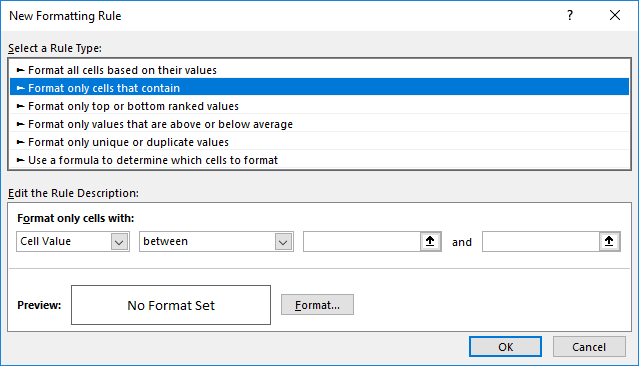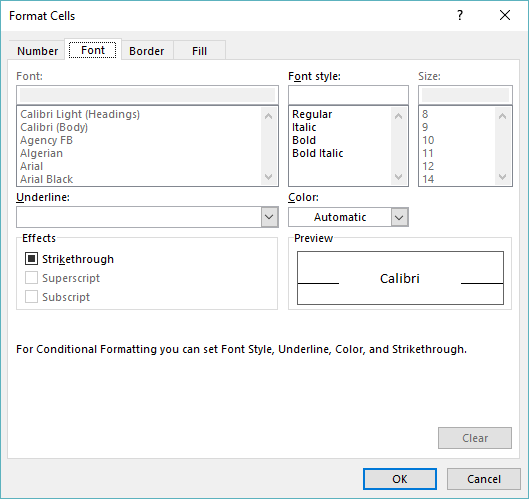Please Note: This article is written for users of the following Microsoft Excel versions: 2007, 2010, 2013, 2016, 2019, 2021, and Excel in Microsoft 365. If you are using an earlier version (Excel 2003 or earlier), this tip may not work for you. For a version of this tip written specifically for earlier versions of Excel, click here: Conditional Formats that Distinguish Blanks and Zeroes.
Written by Allen Wyatt (last updated November 25, 2023)
This tip applies to Excel 2007, 2010, 2013, 2016, 2019, 2021, and Excel in Microsoft 365
Let's say that you routinely import information from another program into Excel. The information contains numeric values, but it can also contain blanks. You might want to use a conditional format on the imported information to highlight any zero values. The problem is, if you just add a conditional format that highlights the cells to see if they are zero, then the condition will also highlight any cells that are blank, since they contain a "zero" value, as well.
There are several different solutions to this predicament. One solution is to apply a conditional format that uses two conditions. The first condition checks for the blanks, and the second checks for zero values. The condition that checks for blanks doesn't need to adjust any formatting, but the one that checks for zero values can. This works because if the first condition is satisfied (the cell is blank), the second condition is never tested. Do the following:

Figure 1. The New Formatting Rule dialog box.
Another solution is to combine your two conditions into a single condition. Follow these steps:

Figure 2. The Format Cells dialog box.
The formula used in step 5 checks to make sure that the value is 0 and that the cell is not blank. The AND function makes sure that only when both criteria are satisfied will the formula return True and the format be applied.
There are any number of other formulas that could also be used. For instance, each of the following formulas could be substituted in step 5:
If you wanted an even faster way to highlight zero values while ignoring blanks, you might consider using a macro. The macro would be faster because you could just import and run it; you don't have to select a range of cells and enter the formula (or formulas) for the conditional formatting. The following macro is an example of one you could use:
Sub FormatRed()
TotalRows = 5000
ColNum = 1
For i = 1 To Cells(TotalRows, ColNum).End(xlUp).Row
Cells(i, ColNum).Interior.ColorIndex = xlAutomatic
If IsNumeric(Cells(i, ColNum).Value) Then
If Cells(i, ColNum).Value = 0 Then
Cells(i, ColNum).Interior.ColorIndex = 3
End If
End If
Next
End Sub
The macro checks the cells in column A. (It checks the cells in rows 1 through 5,000; you can modify this, if desired.) If the cell contains a numeric value and that value is zero, then the cell is filled with red. If the cell contains something else, then the cell is set back to its normal color.
For more ideas about conditional formatting and blank cells, see this site:
https://www.ablebits.com/office-addins-blog/excel-conditional-formatting-blank-cells/
Note:
ExcelTips is your source for cost-effective Microsoft Excel training. This tip (7131) applies to Microsoft Excel 2007, 2010, 2013, 2016, 2019, 2021, and Excel in Microsoft 365. You can find a version of this tip for the older menu interface of Excel here: Conditional Formats that Distinguish Blanks and Zeroes.

Dive Deep into Macros! Make Excel do things you thought were impossible, discover techniques you won't find anywhere else, and create powerful automated reports. Bill Jelen and Tracy Syrstad help you instantly visualize information to make it actionable. You’ll find step-by-step instructions, real-world case studies, and 50 workbooks packed with examples and solutions. Check out Microsoft Excel 2019 VBA and Macros today!
Conditional formatting is a great tool for changing how your data looks based on the data itself. Excel won't allow you ...
Discover MoreIt is easy to apply conditional formatting to a cell. What if you want an entire row to be formatted, however, based on ...
Discover MoreConditional formatting allows you to change how information is displayed based on rules you define. What if you want to ...
Discover MoreFREE SERVICE: Get tips like this every week in ExcelTips, a free productivity newsletter. Enter your address and click "Subscribe."
There are currently no comments for this tip. (Be the first to leave your comment—just use the simple form above!)
Got a version of Excel that uses the ribbon interface (Excel 2007 or later)? This site is for you! If you use an earlier version of Excel, visit our ExcelTips site focusing on the menu interface.
FREE SERVICE: Get tips like this every week in ExcelTips, a free productivity newsletter. Enter your address and click "Subscribe."
Copyright © 2026 Sharon Parq Associates, Inc.
Comments